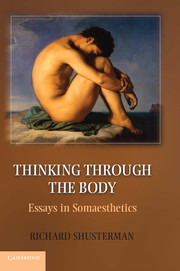Book contents
- Frontmatter
- Contents
- Preface
- Introduction
- Part I Somatic Being, Knowing, and Teaching
- Part II Somaesthetics, Aesthetics, and Culture
- Part III The Arts and the Art of Living
- 10 Somaesthetics and Architecture
- 11 Photography as Performative Process
- 12 Asian Ars Erotica and the Question of Sexual Aesthetics
- 13 Somaesthetic Awakening and the Art of Living
- 14 Somatic Style
- Select Bibliography
- Index
- References
14 - Somatic Style
Published online by Cambridge University Press: 05 November 2012
- Frontmatter
- Contents
- Preface
- Introduction
- Part I Somatic Being, Knowing, and Teaching
- Part II Somaesthetics, Aesthetics, and Culture
- Part III The Arts and the Art of Living
- 10 Somaesthetics and Architecture
- 11 Photography as Performative Process
- 12 Asian Ars Erotica and the Question of Sexual Aesthetics
- 13 Somaesthetic Awakening and the Art of Living
- 14 Somatic Style
- Select Bibliography
- Index
- References
Summary
I
Style is a crucial feature in the arts; not only the fine arts but also in the practical arts of fashion, jewelry, fragrance, cuisine, and product and graphic design. To appreciate how the body is likewise central to the arts, we need only to recognize its crucial role in style. Yet one of America's greatest minds and finest stylists, Ralph Waldo Emerson, has affirmed, “A man's style is his mind's voice. Wooden minds have wooden voices.” If Emerson here defines style through the notion of mind, it is not to deny the somatic dimension of style. Style is essentially embodied, as Emerson's reference to voice clearly implies. Vocalization is clearly a bodily act, involving one's breath, vocal chords, and mouth. Moreover, the materiality of the mind's expression in style is further suggested in Emerson's reference to wooden minds and wooden voices. If we look at the concept of style through etymology, however, we find its somatic roots not in the orality of voice but rather in the bodily gesture of inscription. The word derives from the Latin word stylus, one of whose primary meanings was a sharp instrument used by the Romans for writing and engraving on wax tablets. It thus came, by implication, to convey more generally the method of writing or engraving with any sharp or pointed instrument, such action involving some somatic skill.
From a particular physical tool or method of writing (one notably different from the traditional Chinese use of a soft brush), style's primary meaning has evolved into a more abstract, literary, and lofty sense. Not merely a means of writing or making other kinds of signs, style has become an aesthetic quality whose creation and appreciation forms part of the end of writing and is indeed sought and cherished for its own intrinsic value. Some theorists, however, appeal to style's homely instrumental origin in order to insist that we should confine its role to a practical means for conveying thoughts, so as to ensure that style will not distract from clarity and honesty of communication.
Information
- Type
- Chapter
- Information
- Thinking through the BodyEssays in Somaesthetics, pp. 315 - 338Publisher: Cambridge University PressPrint publication year: 2012
References
Accessibility standard: Unknown
- 1
- Cited by
